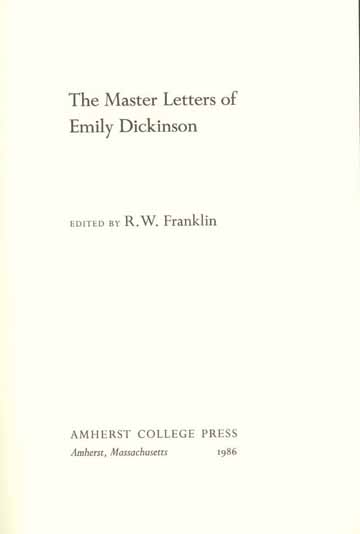reading
and when, among multiple readings, some had been cancelled. In
the resulting text Emily Dickinson's acts of composition and revision
were obscured.
While
also somewhat unsure about the dating, Thomas Johnson revised
Bingham's order for the letters, putting her last first, and supplied
dates for all three: about 1858 ("I am ill"), about
1861 ("If you saw a bullet"), and early 1862?
("Oh, did I offend it")—numbers 187, 233, and
248 respectively in his 1958 edition. The transcriptions, based
on Bingham's, though more literal and accurate than hers, had been
checked against the manuscripts. But the Johnson text,
employing the same symbols as Bingham's, with not much more
description, also left the compositional stages obscured. Both
editors omitted some inscriptions and cancellations.
Jay
Leyda arranged the letters in the same order as Johnson did, but he
assigned different dates, albeit with some, if more precise,
uncertainty: early spring 1858 ("I am ill"), January?
1861 ("If you saw a bullet"), and February? 1861
("Oh! did I offend it"). The Leyda text is
substantially different from either Bingham's or Johnson's, although
it largely derived from hers and was checked, as was Johnson's,
against the manuscripts. Out of the multiplicity of readings,
Leyda redacted a single version. When competing readings stood
uncancelled, he retained only one, choosing editorially between
earlier and later ones. When competing readings did involve
cancellation, he sometimes took the uncancelled reading, sometimes
the cancelled one. When there was a cancelled reading with no
alternatives, he often retained it, as though not to lose it
entirely, but he also eliminated several such readings. Leyda
was preparing copy for a compendium, not for a textual edition, and
his text may be appropriate to its purpose. It is, however, a
mixed version, neither initial nor final, nor indeed reflective of
any particular point in the process of composition and revision.
There
it has stood. The chronology in the present publication grows
out of work in progress that involves dating Dickinson manuscripts
anew. The effect for the Master letters is a revised order that
confirms some previous dates while changing others. The letters are
arranged here in the following order:
Letter 1 spring
1858 ("I am ill")
Letter 2 early
1861 ("Oh - did I offend it")
Letter 3 summer
1861 ("If you saw a bullet")
The
sequence has been determined from aspects of Dickinson's
Introduction 7

